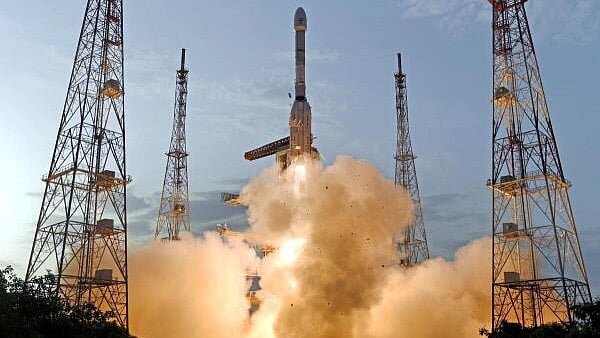
ISRO's launch vehicle GSLV-F16 carrying the NISAR earth observation satellite lifts off from the launch pad at the Satish Dhawan Space Centre, in Sriharikota
Credit: PTI Photo
New Delhi: Following the successful launch of NISAR, India and USA are likely to work closely on more ambitious space projects such as long duration human spaceflight missions, spaceflight safety and planetary protection, sources said here on Wednesday.
In the wake of the jointly developed NISAR earth observation satellite and AX-4 mission that ferried Indian astronomer Group Captain Shubhanshu Shukla to the International Space Station, the two countries are set to look closely at a number of other space collaborations.
“Long duration human spaceflight missions, spaceflight safety and sharing of expertise and professional exchanges in emerging areas, including planetary protection could be some of the areas for collaboration,” sources said.
The two nations are also committed to further commercial space collaboration through industry engagements in conventional and emerging areas, such as connectivity, advanced spaceflight, satellite and space launch systems, space sustainability, space tourism and advanced space manufacturing.
"While the NISAR mission was primarily led by national agencies, it paves the way for the Indian private space sector to actively contribute to such cutting-edge collaborations in near future,” said Lt Gen. AK Bhatt (Retd.), director general, Indian Space Association.
Earlier this year Prime Minister Narendra Modi and President Donald Trump called for more cooperation in the space sector and described 2025 as the year for pioneering space collaboration between the two nations.
This comes two years after India became the 27th signatory in the US-led Artemis Accord to enhance the global governance of civil exploration and use of outer space.
The NASA-ISRO Synthetic Aperture Radar (NISAR) satellite that will scan the Earth’s surface in unprecedented detail is the first joint Earth observation mission of the two space agencies combining their expertise.
"The NISAR mission, being planned and built for over a decade by India and the USA, is a landmark in the collaboration between our nations. The instrument employs radar simultaneously at two frequencies to monitor the earth. Equally important is the way data is being openly shared with the scientific community and public- this sets new standards in space collaboration," said astrophysicist Somak Raychaudhury, Vice Chancellor, Ashoka University
NASA has contributed the L-Band Synthetic Aperture Radar, a high-rate telecommunication subsystem, GPS receivers, and a deployable 12-meter unfurlable antenna. ISRO, on its part, has provided the S-Band SAR payload, the spacecraft bus to accommodate both payloads, the GSLV-F16 launch vehicle, and all associated launch services.
"This is among the biggest international collaborations we have had, especially with a renowned agency like NASA, which was involved (in space) much before us,” said Jitendra Singh, Union Science and Technology Minister.
